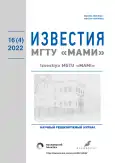The study of fuel accumulation in the oil of a gasoline engine with direct fuel injection
- Authors: Krasnov V.M.1, Terenchenko A.S.1, Timofeev D.S.1, Shibaev I.S.1, Stepin N.D.1
-
Affiliations:
- State Scientific Center of the Russian Federation “NAMI”
- Issue: Vol 16, No 4 (2022)
- Pages: 283-289
- Section: Heat engines
- URL: https://journals.rcsi.science/2074-0530/article/view/126636
- DOI: https://doi.org/10.17816/2074-0530-108497
- ID: 126636
Cite item
Full Text
Abstract
BACKGROUND: The worldwide powertrain engineering tendency is reduction of mass and dimension properties of an engine with simultaneous increase of its specific power and power-to-weight ratio. It can be achieved with compression ratio increase, engine cycle improvement, implementation of supercharging system and direct fuel injection. With the direct injection systems implementation, the issue of fuel accumulation in oil became relevant.
AIMS: The article addresses general issues related to fuel accumulation in the motor oil.
METHODS: Analysis of the published data addressing this issue.
RESULTS: The reasons of fuel entry into oil were formulated, the possible acceptable limits of fuel concentration in oil were defined, and the data of vehicle fleet observation performed by specialists during several years was given.
CONCLUSIONS: There is rather considerable range of opinions and recommendations regarding acceptable fuel concentration in oil. Therefore, it may be concluded that the value of fuel concentration in itself makes little difference, and, in order to define the maximal acceptable level of fuel concentration in oil, it is reasonable to carry out studies of determination acceptable limits of particular motor oil properties, primarily viscosity.
Full Text
##article.viewOnOriginalSite##About the authors
Vladimir M. Krasnov
State Scientific Center of the Russian Federation “NAMI”
Author for correspondence.
Email: vladimir.krasnov@nami.ru
ORCID iD: 0000-0003-4855-9105
SPIN-code: 3726-5821
Cand. Sci. (Tech.), Head of the Research Department of Fuels and Lubricants and Special Fliuds of the Power Units Center Powerunits
Russian Federation, 2 Avtomotornaya street, 125438 MoscowAlexey S. Terenchenko
State Scientific Center of the Russian Federation “NAMI”
Email: terenchenko@nami.ru
ORCID iD: 0000-0002-1371-3179
SPIN-code: 8166-4320
Cand. Sci. (Tech.), Head of the Power Units Center
Russian Federation, 2 Avtomotornaya street, 125438 MoscowDmitriy S. Timofeev
State Scientific Center of the Russian Federation “NAMI”
Email: dmitry.timofeev@nami.ru
ORCID iD: 0000-0002-9946-4440
SPIN-code: 3083-1135
Head of the Sector of Units, Parts and Systems of Diesel Engines of the Power Units Center
Russian Federation, 2 Avtomotornaya street, 125438 MoscowIvan S. Shibaev
State Scientific Center of the Russian Federation “NAMI”
Email: ivan.shibaev@nami.ru
ORCID iD: 0000-0001-7741-9860
Head of the Internal Combustion Engines Department of the Power Units Center
Russian Federation, 2 Avtomotornaya street, 125438 MoscowNikita D. Stepin
State Scientific Center of the Russian Federation “NAMI”
Email: nikita.stepin@nami.ru
ORCID iD: 0000-0002-2826-7677
Chief Planning Specialist of the Project Management Center
Russian Federation, 2 Avtomotornaya street, 125438 MoscowReferences
- Aviation Machinist’s Mate 2. Washington: Bureau of Naval Personnel; 1961. Available from: https://books.google.ru/books?id=CBPeNed9_Y0C&pg=PA2&dq=Aviation+Machinist’s+Mate+2&hl=ru&sa=X&ved=0ahUKEwjSgIrp3urmAhUm0aYKHQmTDL4Q6AEIKDAA#v=onepage&q=Aviation%20Machinist’s%20Mate%202&f=false accessed: 14.04.2022.
- Zhou Y, Li W, Stump BC, et al. Impact of Fuel Contents on Tribological Performance of PAO Base Oil and ZDDP. Lubricants. 201;6(3):79. doi: 10.3390/lubricants6030079
- Ostrikov VV, Nagornov SA, Kleimenov OA, et al. Fuel, lubricants and technical fluids: a tutorial. Tambov: Izd-vo Tamb. gos. tekhn. un-ta; 2008. (in Russ).
- Ljubas D, Krpan H, Matanovic I. Influence of engine oils dilution by fuels on their viscosity, flash point and fire point. Nafta. 2010;61(2):73–79. Available from: https://hrcak.srce.hr/49121 accessed: 14.04.2022.
- Hu T, Teng H, Luo X, et al. Impact of Fuel Injection on Dilution of Engine Crankcase Oil for Turbocharged Gasoline Direct-Injection Engines. SAE Int. J. Engines. 2015;8(3):1107–1116. doi: 10.4271/2015-01-0967
- Döhler A, Pritze S. A contribution to better understanding the pre-ignition phenomenon in highly charged internal combustion engines with direct fuel injection. In: 4th conference knocking in gasoline engines, Berlin, 9–10 October 2013. Berlin: IAV Automotive Engineering GmbH; 2013:41–61.
- Mayer M, Hofmann P, Williams J, et al. Influence of the Engine Oil on Pre-ignitions at Highly Supercharged Direct-injection Gasoline Engines. MTZ Worldw. 2016;77:36–40. doi: 10.1007/s38313-016-0044-z
- Grinchenko KV, Korneev SV, Buravkin RV. Changes in the properties of engine oil when fuel enters. Dinamika sistem, mekhanizmov i mashin. 2016;1:158–162. (in Russ).
- What is Fuel Dilution (and why is it bad)? [internet] Available from: https://blog.amsoil.com/what-is-fuel-dilution-and-why-is-it-bad/ accessed: 21.03.2022.
- How gasoline engine technology affects fuel dilution. [internet] Available from: https://polarislabs.com/how-gasoline-engine-technology-affects-fuel-dilution/ accessed: 29.03.2022.
- Best Tests to Detect Fuel Dilution. [internet] Available from: https://www.machinerylubrication.com/Read/31148/fuel-dilution-tests accessed: 13.05.2022.
- Engine oil analysis for gasoline and diesel engines. [internet] Available from: https://www.oillab.ru/dvigatel/bazovyy-kompleks-ispytaniy-masla-dlya-dvigatelya/ accessed: 25.05.2022. (in Russ).
- FAQ on laboratory tests. [internet] Available from: https://www.oil-club.ru/faq-po-labor atornym-analizam/ accessed: 25.04.2022. (in Russ).
Supplementary files












